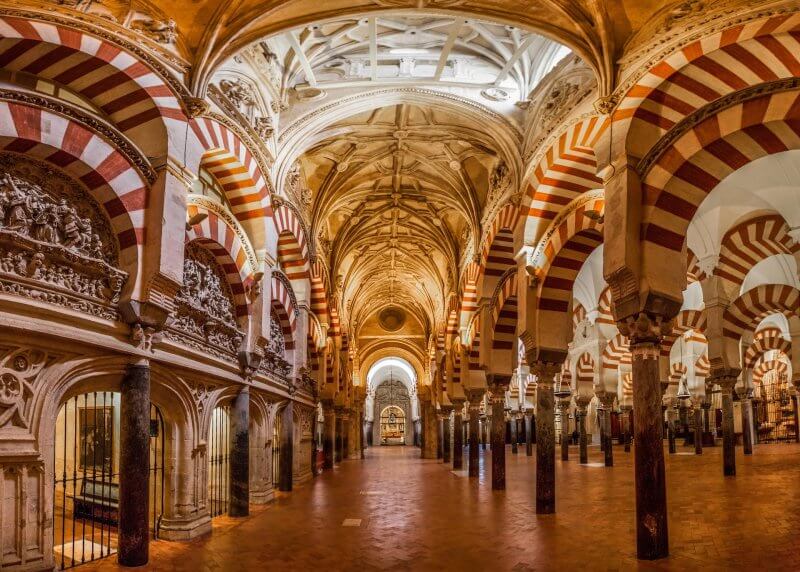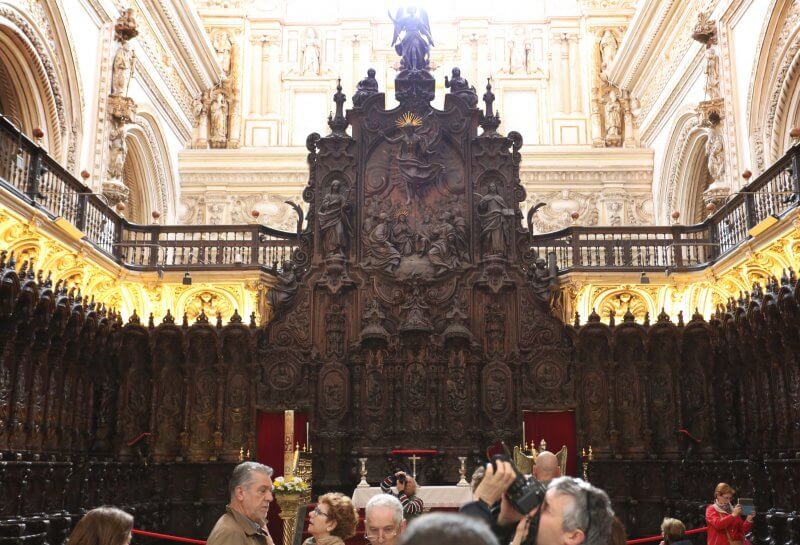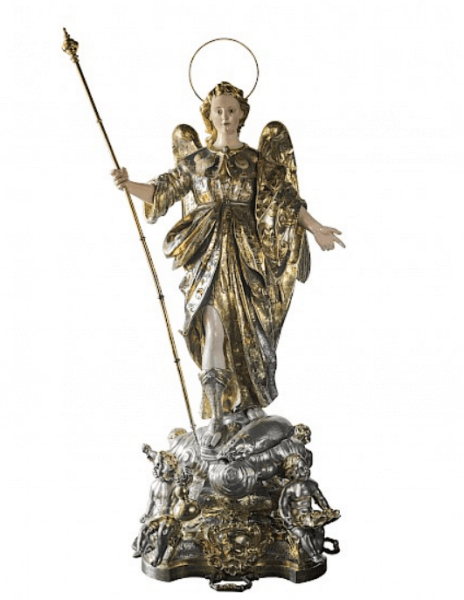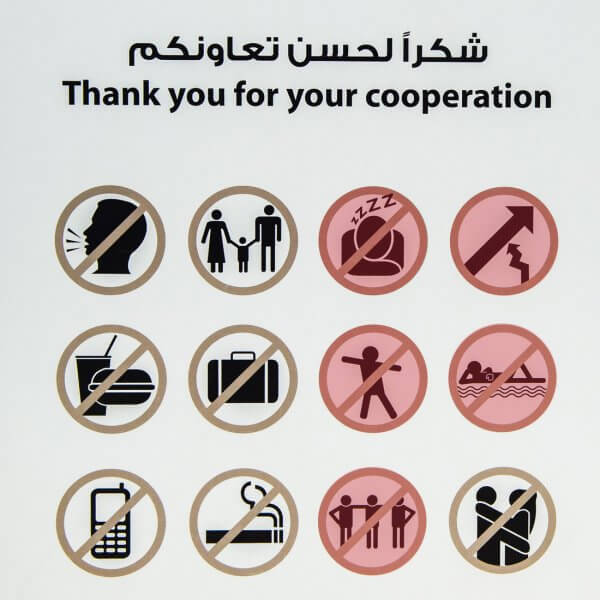The Mezquita, Cordoba is a Roman Catholic cathedral that was previously a mosque. It is the main attraction of the city and the largest church in Andalusia. Every year, over 1.5 million tourists visit this place.

General information
The Mezquita is a cathedral mosque built in Cordoba in 784. During the Middle Ages, it was the second-largest Muslim mosque in the world, and it is now considered the most famous architectural structure in Spain, built during the Umayyad dynasty. It is currently one of the top four largest mosques in Europe.
The Mesquita is known primarily as one of the most beautiful and oldest mosques in Europe. Its interior is striking in its beauty and opulence, with golden prayer niches, tall double arches of black onyx and jasper, and a majestic blue dome with pale stars in the center.
The attraction is located in the center of authentic Cordoba, near the Córdoba Central train station and the synagogue, on the banks of the Guadalquivir River.
What to see in Seville – Top 15 notable sites
Historical background
The history of Mesquita in Cordoba (Spain) is very long and complicated. So, its construction began in 600, and initially it was mentioned in the annals as the Church of St. Vincent of Zaragoza. Later it was converted into a mosque, and in the early 710s the building was completely destroyed.

In 784, a new Muslim mosque was built on the same site by Emir Abd al-Rahman I, who wanted to immortalize his wife’s name in history. Over the course of 300 years, the building was constantly renovated and new decorative elements were added. The large interior arches made of onyx, jasper, and granite, which are still a prominent feature of the mosque, attracted significant attention.
After the Reconquista (the Christian-Muslim struggle for the lands of the Iberian Peninsula) ended in Spain, the Mosque of Mezquita was converted into a church, and until the end of the 18th century, the temple was regularly added to and decorated with new details. Today, it is an active Roman Catholic church.
Mosque architecture
Contrary to popular belief, the Mesquita is not just a mosque, but a vast complex that includes chapels from different historical periods, a large orange orchard, and other attractions.
The mosque itself in Cordoba is made of yellow sandstone, and the window openings and entrance doors are decorated with ornate oriental patterns. The original Mesquita was built in the Moorish style, but due to numerous additions and renovations, it is difficult to determine its current architectural style. It can be described as a mix of Moorish, Gothic, and Marrocan styles.

Territory
Pay attention to the Chapel of Villavicios, which was built by Catholic believers, and the Royal Chapel, where several European monarchs were previously buried (it is currently closed to the public).
The Orange Courtyard is the most beautiful place in the complex, with palm trees, citrus fruit trees, and exotic flowers.
The tower that rises above the temple complex is a former minaret, which, with the arrival of Christianity in these lands, became an ordinary watchtower. Interestingly, a sculpture of the city’s patron, Archangel Raphael, is now installed on its top.
Interior decoration
Tourists are enthusiastic about the interior of the Cathedral Mosque in Cordoba. Many say that this is the only place where you can see Muslim patterns combined with Catholic statues and an altar.

Interestingly, you can read about the beauty of the Mezquita not only in modern travel guides about Spain, but also in the collection of poems by the famous German poet Heinrich Heine “Almansor” and in the travel notes of the Russian traveler Botkin. Also, a number of works by the American artist Edwin Lord Weeks are dedicated to the mosque.
The most common types of map items are the following::
- Pillared hall. This is the most famous room in the mosque, and the most “Muslim”. In this part of the mosque stands about 50 arches, painted in white and red tones (which is typical of the Moorish style). Once in this part of the Umayyad Mosque in Cordoba, it is hard to believe that you are in a temple, and not in the palace of the emir.
- An equally important part of the temple is the Mirhab. It is a large gilded room with a niche in the wall that contains phrases from the Quran. For Christians, it is very interesting from an architectural standpoint.
- The Cathedral of Cordoba. You could say that the Mesquita is a building within a building, as there is a Gothic-style Catholic church located right in the center of the mosque. It is worth noting the carved mahogany choir and the stone statues.
- The Catholic choir is made of mahogany. It is one of the oldest and most exquisite parts of the church, dating back to 1742. Each section of the choir is adorned with intricate carvings that reflect different historical eras and individuals. Despite its age of almost 300 years, this remarkable piece of art has remained intact due to the quality of the material and the craftsmanship of the artist.
- The retablo or altar is the central part of any church. The main altar was made in 1618 from rare Cabrino marble.

The Treasury
The Treasury is the most interesting room in the Great Mosque of Cordoba, which contains a number of interesting and very valuable exhibits: gold cups, silver bowls, personal belongings of bishops, and rare gemstones. The most unique museum items include:

- Reliefs from the facade of the mosque and pillars from the 6th and 7th centuries.
- The icons of the Marquis de Comares Rodrigo de León. These are not individual images of saints, but a single work of art in the shape of a palace, encrusted with precious stones.
- Painting “Saint Eulogius Vicente” by Vincenzo Carducci. The canvas depicts the Cordoban martyr Saint Eulogius, who looks at the angel in surprise.
- The sculpture “Saint Raphael” is one of the six masterpieces by Damian de Castro. The process of creating this work is truly unique – first, from a solid piece of wood, the master carves a sculpture, and after that, he covers it with silver and gold using special plates.
- The altarpiece of Our Lady of the Rosary by Antonio del Castillo. This is an altarpiece consisting of four paintings by Antonio del Castillo. Above it is Our Lady of the Rosary, flanked by the intercessors Saint Sebastian and Saint Roch, and completed by a crucifixion.
- The painting “Saint Michael” by Juan Pompeyo.
- The sculpture “Saint Sebastian”. This is an elegant sculptural composition consisting of a young man resembling Apollo and an angel. The piece is cast in silver.
- The most valuable exhibit is the tabernacle, which was cast in 1514 and is still used in worship services.
Visiting rules

- It is forbidden to wear shorts and short skirts in the church. Clothing should cover the shoulders, knees, and décolleté, and should not be provocative. It is also forbidden to enter the church with a hat.
- During the service, which takes place daily from 8:30 a.m. to 10:00 a.m., it is forbidden to walk around the mosque or take photos.
- You are not allowed to enter the church with large bags or packages.
- In the Cordoba Mosque, it is necessary to speak quietly so as not to disturb the worshippers.
- It is forbidden to enter the Mosque with pets. The only exception is guide dogs.
- Smoking is strictly prohibited on the premises.
- Minors must be accompanied by an adult.
- If you are part of a group of more than 10 people, you must take an audio guide at the entrance.
Thus, there are no special rules in the Mosque – everything is the same as in other churches. It is important to simply follow the general rules of decency and treat the believers with respect.
Practical information
- Address: Calle del Cardenal Herrero 1, 14003 Córdoba, Spain.
- Working hours: 10:00-18:00, Sunday: 8:30-11:30, 15:30-18:00.
- Admission fee: 11 euros (entire complex) + 2 euros (bell tower tour) for adults. 5 euros for children. 4 euros for an audio guide. Free admission is available for residents of Córdoba, people with disabilities, and children under 10 years old.
- Official website: https://mezquita-catedraldecordoba.es/

Useful tips
- It’s better to buy tickets online in advance on the official website, as there are usually long queues at the ticket offices, and you may have to wait for about an hour.
- If you want to visit the Mezquita in Spain for free, you can purchase the Andalucia Junta 65 card, which guarantees free admission to several attractions in Cordoba.
- Every morning, from 8:30 a.m. to 10:00 a.m., the mosque is open for free.
- Tours of the bell tower of the Umayyad Mosque in Cordoba are held every half hour.
- The mosque has the fewest tourists between 2 p.m. and 4 p.m.
- In addition to the traditional daytime tour, tourists can visit the Mescita at night, when the mosque looks even more mysterious and beautiful in the light of torches and candles. The first tour starts at 21:00, and the last tour starts at 22:30. The cost is 18 euros.
The Mezquita in Cordoba is one of the most unusual and spectacular landmarks in Andalusia, and it is definitely worth a visit.

